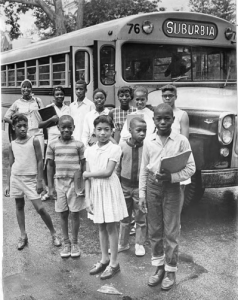
This picture depicts 12 African-American students in front of a bus in 1968. The bus reads, “Suburbia.” The children are from the Hartford area but are being bussed to suburbs to attend other schools. This photo shows attempts at school integration despite residential segregation. Because where you live determines where you go to school, bussing is necessary to get minority students who don’t have access to housing in better neighborhoods to higher quality schools. In the following video, Susan Hansen is enlightened of this housing segregation that existed in her neighborhood in the 1940s.
Source: Hansen, Susan. Oral history interview on West Hartford, CT and restrictive covenants (with video), by Candace Simpson for the Cities, Suburbs, and Schools Project, July 22, 2011.Available from theTrinity College Digital Repository, Hartford Connecticut (http://digitalrepository.trincoll.edu/cssp/).
The interviewer, Candace Simpson, reads Susan Hansen a racially restrictive property deed from West Hartford in the 1940s. The property deed explicitly said that “no persons of any race, except the white race, shall use or occupy any building on any lot.” Susan, extremely surprised and confused, says, “I’m shocked… I can’t even comprehend it…. its not something I would have expected in Connecticut at all” (3:50 – 4:05). This interview shows how many people were unaware that such blatant racism existed in housing. These discriminatory actions not only affected the housing market for minorities but also school choice. That is why the picture of bussing in the 1960s is so significant.